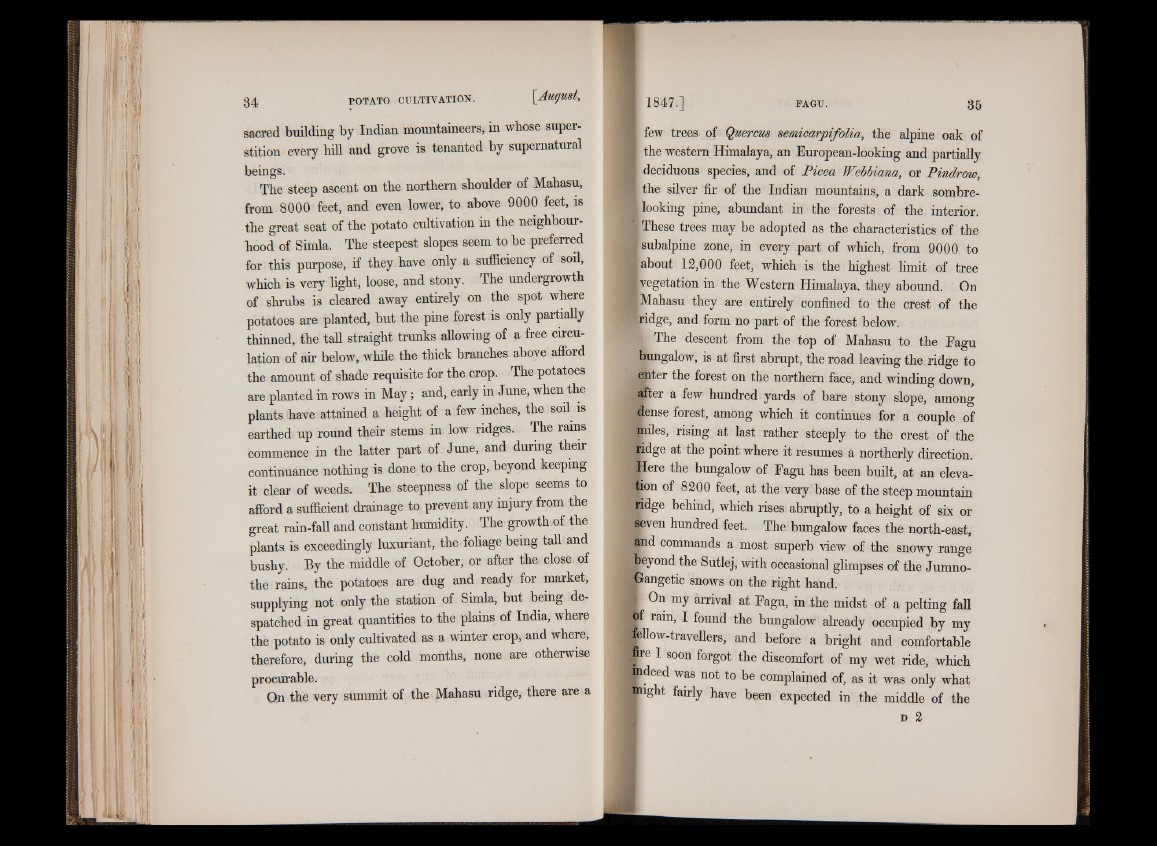
sacred building by Indian mountaineers, in whose superstition
every hill and grove is tenanted by supernatural
beings.
The steep ascent on the northern shoulder of Mahasu,
from 8000 feet, and even lower, to above 9000 feet, is
the great seat of the potato cultivation in the neighbour-
liood of Simla. The steepest slopes seem to be preferred
for this purpose, if they have only a sufficiency of soil,
which is very light, loose, and stony. The undergrowth
of shrubs is cleared away entirely on the spot where
potatoes are planted, but the pine forest is only partially
thinned, the tall straight trunks allowing of a free circulation
of air below, while the thick branches above afford
the amount of shade requisite for the crop. The potatoes
axe planted in rows in May ; and, early in June, when the
plants have attained a height of a few inches, the soil is
earthed up round their stems in low ridges. The rains
commence in the latter part of June, and during their
continuance nothing is done to the crop, beyond keeping
it clear of weeds. The steepness of the slope seems to
afford a sufficient drainage to prevent any injury from the
great rain-fall and constant humidity. The growth of the
plants is exceedingly luxuriant, the foliage being tall and
bushy. By the middle of October, or after the close of
the rains, the potatoes are dug and ready for market,
supplying not only the station of Simla, but being despatched
in great quantities to the plains of India, where
the potato is only cultivated as a winter crop, and where,
therefore, during the cold months, none are otherwise
procurable.
On the very summit of the Mahasu ridge, there are a
I few trees of Quercus semicarpifolia, the alpine oak of
I the western Himalaya, an European-looking and partially
I deciduous species, and of Picea Webbiana, or Pindrow,
I the silver fir of the Indian mountains, a dark sombre-
1 looking pine, abundant in the forests of the interior.
■These trees may be adopted as the characteristics of the
■subalpine zone, in every part of which, from 9000 to
■ about 1 2 ,0 0 0 feet, which is the highest limit, of tree
■vegetation in the Western Himalaya, they abound. On
■Mahasu they are entirely confined to the crest of the
? ridge, and form no part of the forest below,
jr The descent from the top of Mahasu to the Fagu
^ungalow, is at first abrupt, the road leaving the ridge to
enter the forest on the northern face, and winding down,
lifter a few hundred yards of bare stony slope, among
dense forest, among which it continues for a couple of
miles, rising at last rather steeply to the crest of the
ridge at the point where it resumes a northerly direction,
■ e re the bungalow of Fagu has been built, at an eleva-
tion of 8200 feet, at the very base of the steep mountain
ridge behind, which rises abruptly, to a height of six or
seven hundred feet. The bungalow faces the north-east,
B id commands a most superb view of the snowy range
B®yond the Sutlej, with occasional glimpses of the Jumno-
Brangetic snows on the right hand.
K my Clival at Fagu, in the midst of a pelting fall
V rain, I found the bungalow already occupied by my
■llow-travellers, and before a bright and comfortable
■re I soon forgot the discomfort of my wet ride, which
■deed was not to be complained of, as it was only what
■tight fairly have been expected in the middle of the
d 2